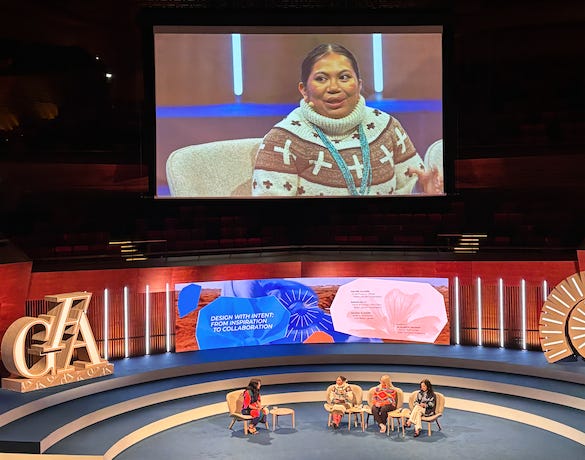Insights from Global Fashion Summit
The Global Fashion Summit celebrated its 15th anniversary, reflecting on the industry's progress since its inception in 2009. The Bergstrand team attended the summit and here are our key takeaways.
Leadership, Collaboration, and Action
Paul Polman, author of Net Positive, kicked off the summit "Unlocking the Next Level" with a compelling question: "Do you care?" and urged the industry to embrace a net positive approach through collaboration and science-based target setting.
The summit highlighted the critical need for investment and progress across the fashion value chain. The CEO of Global Fashion Agenda, Federica Marchionni's opening remarks and Peder Michael Jorgensen's insights emphasised the importance of transformative collaboration and equitable financial distribution. A recurring theme was data-driven decision-making, emphasising the need for data collection, collaboration, and standardisation to maintain transparency.
In his closing address, Patagonia CEO Ryan Gellert challenged attendees to shift from passive hope to active collective action, redefining success in the fashion industry through Patagonia's example of leadership in both business and environmental advocacy.
Alternative Business Models and Avoiding Over Supply
With resale projected to grow, the potential for brands to profit without producing new garments is considerable. As a response to this, the Ellen MacArthur Foundation has presented its Fashion ReModel initiative, involving Arc'teryx and Zalando, promoting rental, repair, remake, and resale models for a circular economy.
Vanessa Friedman, American fashion journalist, highlighted overproduction, with textile waste expected to hit 148 million tonnes by 2030. The "Ending Oversupply" discussion proposed AI for better forecasting.
Barriers in using recycling
Recycling old clothes into new garments remains a challenge, with less than 1% currently being recycled. The upcoming Ecodesign for Sustainable Products Regulation will require using recycled fibres, but standards for durability and performance are lacking. Recycled fibres must be integrated into main collections, not just small capsules, and translated into KPIs across all brand departments to create demand and lower costs.
"Action over perfection" was a key theme during panel discussions. Brands must increase demand for recycled fibres to improve technology and scale up. Collaboration among sorters, collectors, recyclers, and brands is essential, along with more transition funding to move from lab to scale. Technological advancements in textile-to-textile and garment-to-garment recycling were also discussed.
Living wages and collective bargaining
Major companies like PVH, H&M, and ASOS have signed agreements to support higher wages for Cambodian garment workers. Experts stress the need for more brands to commit legally to ending unfair labour practices and low wages. Stability in supply chains is crucial, with legally binding agreements ensuring living wages and workers' rights.
Underrepresented voices
Research shows only 5% of fashion brands consider Indigenous communities in decision-making, despite their management of 80% of the world’s biodiversity. This relationship involves design and sustainability, with concerns about cultural appropriation, intellectual property, and traditional crafts.
Representatives from Polo Ralph Lauren discussed their framework of Collaboration, Compensation, and Credit, which aims to include Indigenous voices and those from the supply chain in the design process, ensuring cultural collaboration rather than appropriation.
EU and National level legislation
The impact of policies, both in the EU and globally, was a central theme at the summit. With the EU Strategy for Sustainable and Circular Textiles in focus, brands face challenges in complying with various regulations. As national legislation rolls out in Europe and the US, brands must adapt to new requirements. Discussions highlighted concerns about whether Ecodesign requirements will hinder designers. Embracing a circular economy involves more than just recycling; it requires designing for circularity and improving supply chains.
A New Way of Thinking
The Global Fashion Agenda's Trailblazer Programme supports early-stage innovations. This year's winner, Bloom Labs, converts natural waste into high-performance textiles, reducing reliance on virgin resources. Innovative alternatives, including seaweed-based fibers and banana by-products, were showcased, along with synthetic-free leather alternatives.
What was missing?
Despite numerous engaging discussions at the summit, covering all sustainability aspects in fashion remains challenging. Biodiversity, a crucial topic for future brand accountability, received little attention. Supporting indigenous communities, which oversee 80% of global biodiversity, is one solution, but what other actions can we take?
The representation of manufacturers and farmers, who supply the fibres for our garments, was notably absent. As legislation increases and brands face more requirements, collaboration across the value chain is essential, amplifying voices from the source.
The current fashion model is unsustainable. Feeling uneasy signals the need for change, as Patagonia CEO Ryan Gellert emphasised. Hope alone won't drive progress; action is imperative. We possess solutions but lack the will to implement them — a mindset shift is necessary. So, as Paul Polman asks, do you care?
Upcoming Newsletters
EU Legislations: Part 3. What is the Corporate Sustainability Reporting Directive (CSRD)?
Regenerative agriculture: What is regenerative farming and why is it important for fashion?
What we’re reading this month
PFAS ban in Denmark - Denmark's government has proposed to introduce a national ban on PFAS in clothing, shoes and waterproofing agents that will start in two years' time.
Fashion show in Atacama Desert - Activists and designers organised an event to raise awareness of the clothes dump visible from space.
Planting trees to combat global warming is more complex than we think - While trees absorb carbon emissions, the practice of tree planting must be carefully managed to avoid detrimental effects on local ecosystems and biodiversity.
“Blue Beauty” the new trend in beauty - An increasing number of cosmetics and skincare brands are marketing themselves as 'ocean friendly'.
Is BCI cotton really as good as some may think? - BCI asserts that the cotton produced under its program uses fewer pesticides, improves farmers' living standards, and ensures safer chemical use. However, these claims have not been independently verified by any study.






